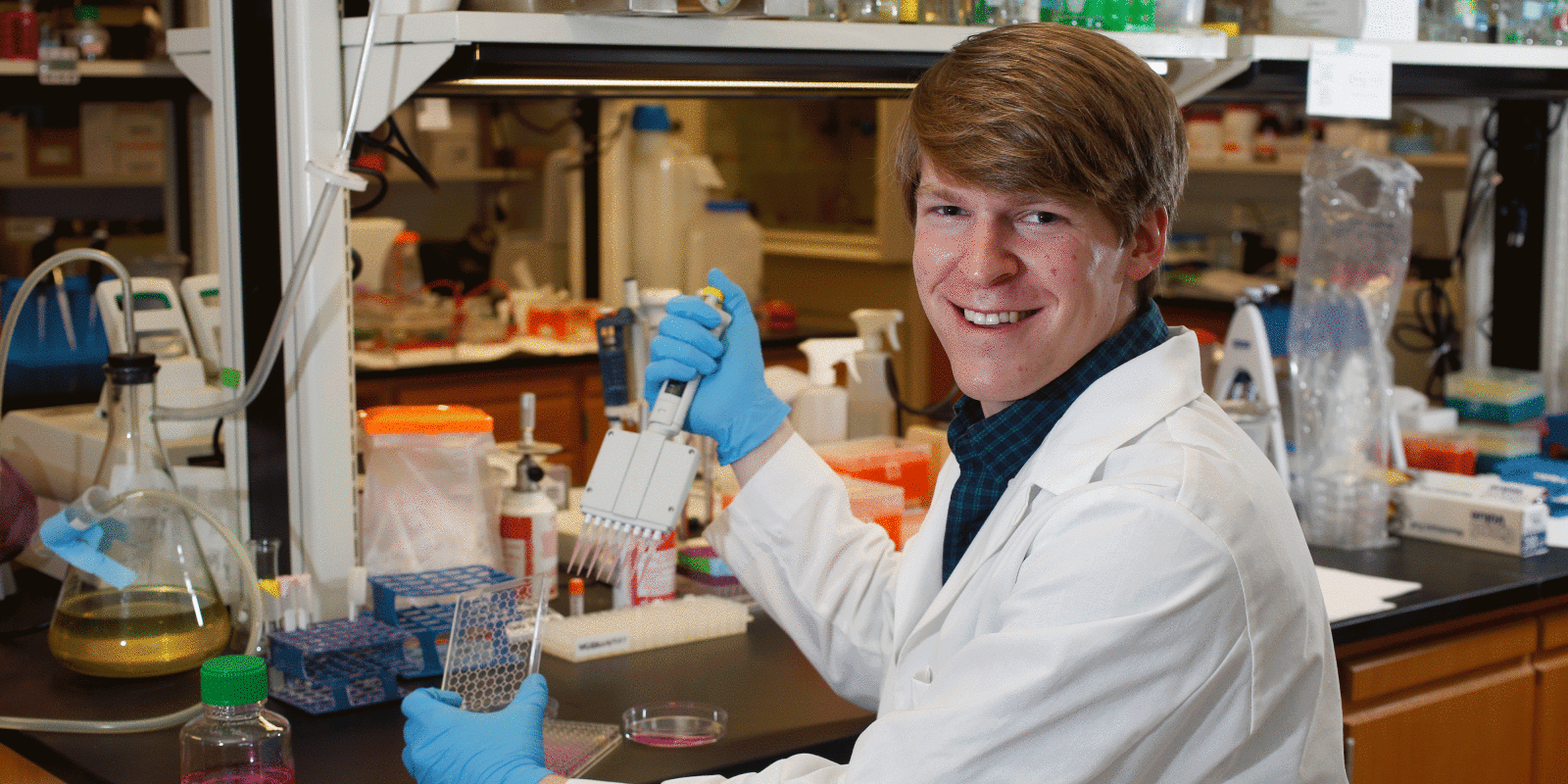
The Genetics of Anthrax
Kevin Claunch ’14 postponed medical school to do research in microbiology. His work might lead to medicines able to disarm anthrax or even common staph infections.
Studying the microscopic building blocks of the bacteria that causes anthrax might sound dangerous or complex to some college students, but Kevin Claunch ’14 understood the potential impact of his research endeavor.
If Claunch could inactivate one crucial gene in the bacteria, drug researchers might use his research to develop a medicine to disarm specific genes as a pathway to inactivating anthrax or even common staph infections, something that could have “huge clinical significance,” he said.
To be specific, Claunch, who is now a master’s student in biology at TCU, explored how the lrgA gene of Bacillus anthracis might apply to the functioning of the human immune system.
“You really have to think about it, and that’s what I like about sciences”
Claunch
But the Fort Worth native originally did not plan to study in microbiology. When he started at TCU, he was in the pre-med track with plans to become a physician. His experience a microbiology course taught by Shauna McGillivray, associate professor of biology, however, piqued his curiosity and changed the direction of his studies.
“I never thought I was going to fall in love with it,” said Claunch about his work with the genetics of bacteria.
He begged McGillivray for a spot in her research lab. She granted him one. The professor “gave me this focused and individualized attention,” said Claunch.
McGillivray said lab research augments classroom material, and the most important lessons involve a certain measure of independence. “I’ll help you, but you try to take some ownership,” the professor said of her mentoring style.
Around 40 percent of biology majors take on substantial research projects, said McGillivray.
In assigning research areas to undergraduate students, McGillivray explained that she likes to first assess “what are their goals and how is this experience going to be helpful or beneficial to them?”
Considering Claunch’s interest in health sciences, McGillivray gave him a study that might apply to both microbiology and a pathogenic human health problem. No researchers in her lab had tackled lrgA and B genes, and specifically, whether making those genes inactive might weaken bacterial cell walls to the point of allowing for effective antibiotic treatment of thorny pathogens.
During his junior year, Claunch assumed responsibility for studying the two downstream genes of clpX, a “master” gene of the bacteria that McGillivray has been researching since her graduate school days at the University of California, San Diego.
Claunch had to flex his critical thinking and data-analysis skills, transitioning textbook knowledge into real-world application. “You really have to think about it, and that’s what I like about sciences,” he said.
The next spring semester, Claunch outlined his project as part of applying for a prestigious American Society for Microbiology undergraduate research fellowship. McGillivray encouraged him to devote considerable space to explaining the reason the research was important.
Claunch won the fellowship and its $4,000 stipend. The money allowed him to spend the summer before his senior year working full-time in the microbiology lab. He started the work by combining a plasmid –- a circular DNA strand commonly used to manipulate genes — into bacteria. He essentially scrambled the lrgA so that it could not be read properly.
“It’s kind of like if you’re reading a sentence in a book, and you just chunk a huge series of letters in the middle, the sentence won’t read the same,” he said about the deactivation process. “It doesn’t make any sense any more.”
Using a polymerase chain reaction machine, Claunch checked whether he had disabled the correct gene. Satisfied with the results, he inserted the entire sequence into both the anthracis and staphylococcus bacteria. (The anthrax-causing strain had been weakened to the point it was incapable of causing a human infection.)
“I never thought I was going to fall in love with it”
Claunch on research
After setting up controls to ensure the accuracy of his experiment, Claunch grew the altered bacteria in the presence of both antibiotics and a molecule meant to mimic the reaction of the human immune system.
He continued his research work throughout his senior year, collecting data and giving numerous presentations of his results. “The biggest challenge with that was getting this information at least relatable to people who are not in sciences,” he said.
Claunch delivered his research findings at an American Society for Microbiology conference in Boston. Even though the effect was less powerful than when clpX (the gene McGillivray studies) was deactivated, “lrgA has some kind of role in virulence,” he said.
Through his undergraduate research work, Claunch discovered that he wanted to do more work in biology. “You can get these really powerful outcomes.”
With eyes still on medical school, Claunch plans to finish his master’s degree in biology first. He said he owes the expanded perspective to the extra time he spent in the lab.
Claunch won TCU’s Boller Award for outstanding research in the John V. Roach Honors College. “It was a very huge shock,” he said. “I didn’t even know there was a competition.”

Your comments are welcome
Comments
Related reading:
Features, Research + Discovery
Spiders as Mercury Contaminators
Are spiders a missing link as toxic mercury moves from water onto land?
Features, Research + Discovery
The Other Silk Road
Wesley Lacson ’15 conducted research on the Silk Road marketplace from a business perspective.